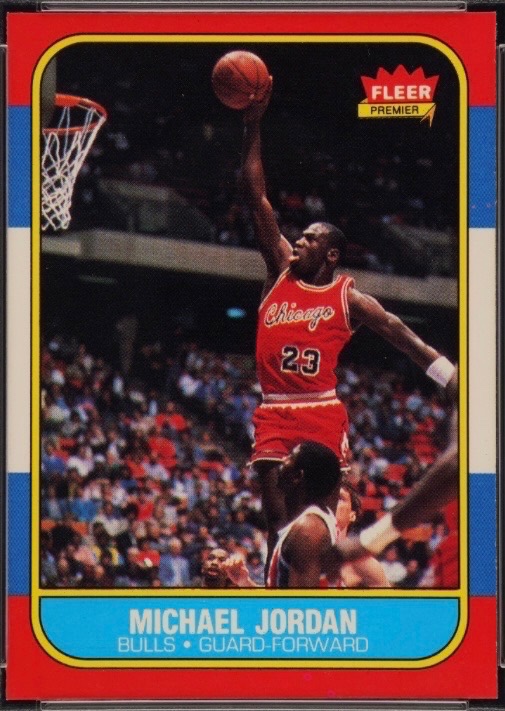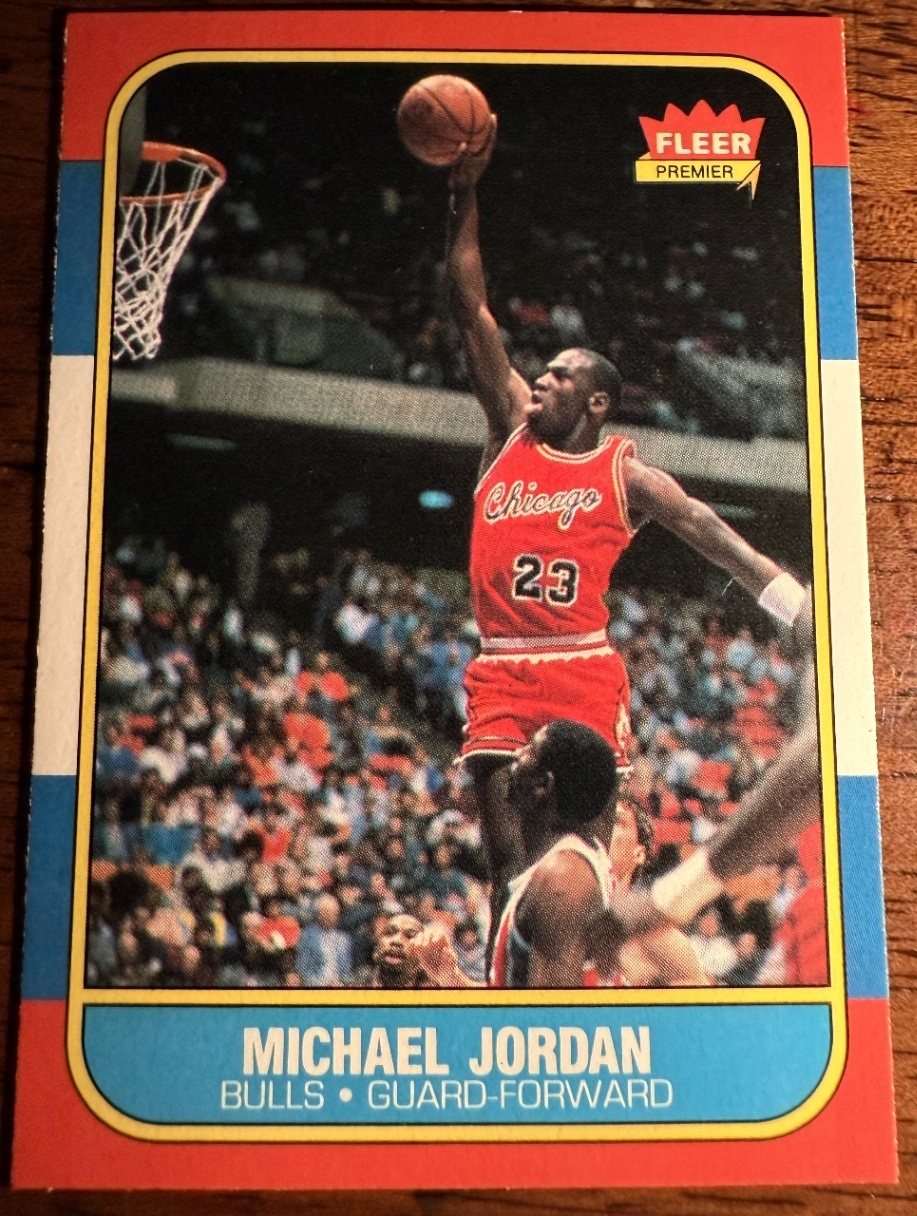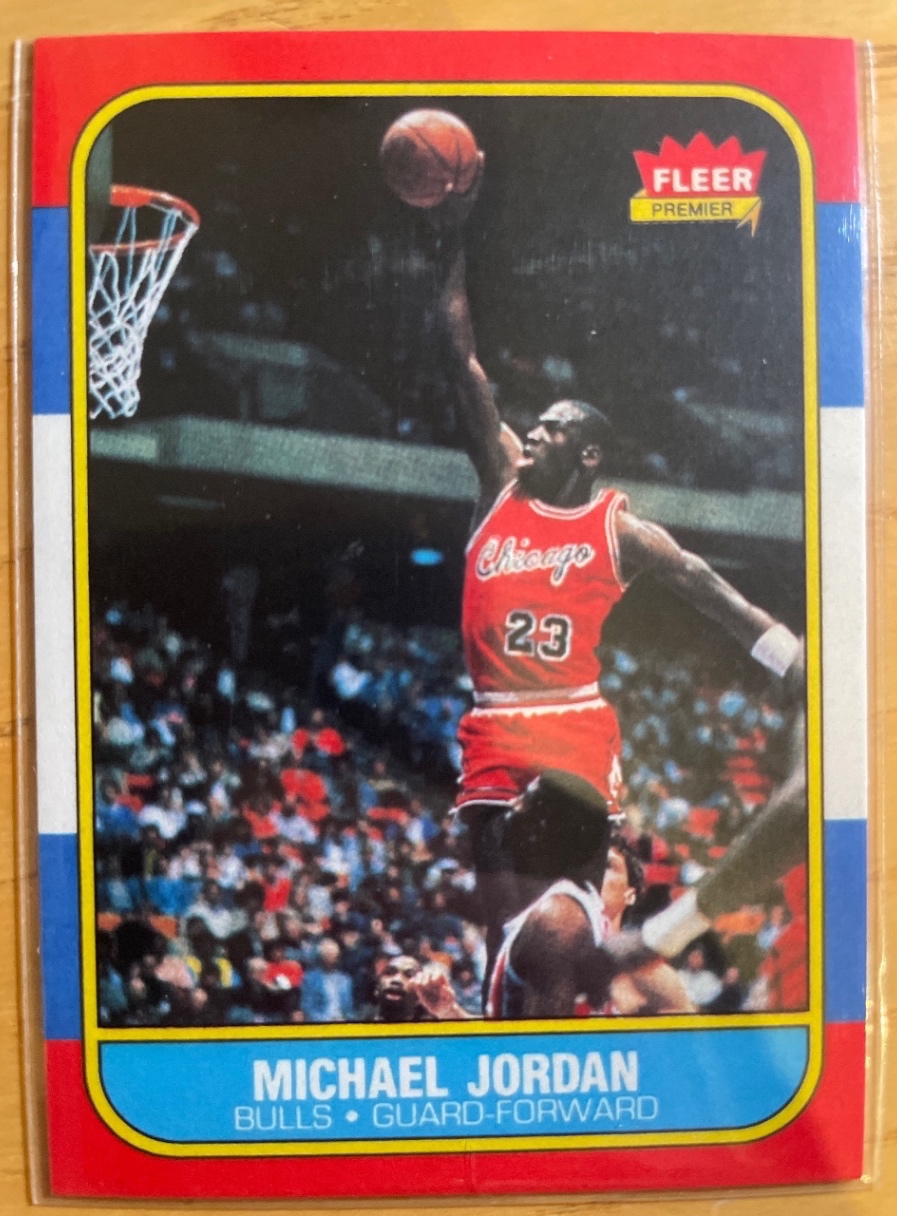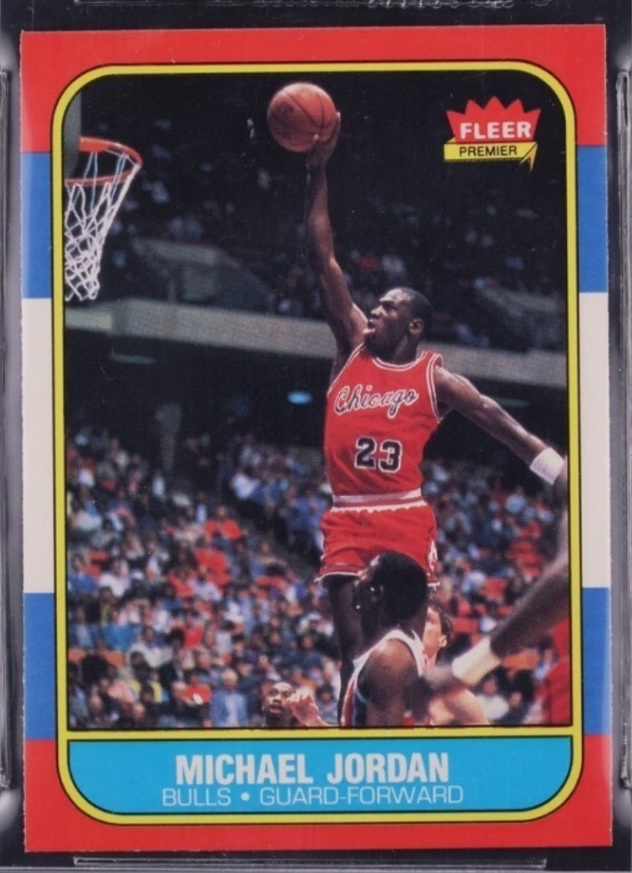The Thousand‑Dollar Millimeter: Subtle 1986 Fleer Michael Jordan Differences That Move Grades and Markets
1986 Fleer, Epic by Design: How Microscopic Differences Create Macroscopic Value
The 1986-87 Fleer Michael Jordan rookie (#57) is a card that turns millimeters into money. A hair of centering, a pinprick of edge chipping, a faint surface line—each can swing a grade, and with it, thousands of dollars. Let’s dissect four real Jordans our AI graded, compare them to exact-match sales, and make the subtle feel obvious.
Tap to Dunk: a tiny homage to a legendary leap
A little flair for a Fleer classic—tap the button, then watch MJ rise.

No holo. No serial numbering. Just timeless composition: blue sky, red keyline, a hang-time snapshot that became the hobby’s north star. That’s why tiny flaws loom large—because the design is otherwise flawless.
Subtle differences that move a grade (and thousands of dollars)
1986 Fleer is unforgiving. The bold red border exposes corner wear. The blue backdrop spotlights print dots and surface lines. And centering—left/right and top/bottom—dominates eye appeal. Below, we justify four different AI grades with the tiny tells that separate a mid-grade from a near-gem.
1) The near-gem that roars: 1986 Fleer Michael Jordan Base (AI 9.06)

- Centering: Slightly off-center, but within what many graders tolerate for a 9-level card.
- Corners/Edges: Front corners and edges are exemplary; back shows only minuscule specks.
- Surface: Exceptionally clean—no scratches or discoloration noted.
- Value logic: Our estimate pegs a graded value around $22,000. That lines up with a BGS 9.5 sale at $27,500 (Aug 10, 2025), and typical PSA 9 ranges. Jumping from an 8 to a 9 is a steep market step on this card.
2) Two 7s, not the same story: 1986 Fleer Michael Jordan Base (AI 7.79) vs. 1986 Fleer Michael Jordan Base (AI 7.31)

AI 7.79: Slightly off-center, a few tiny white specks, and a light surface scratch. This is the kind of card that lives on the PSA 7/8 border. Our EV (~$7,500) reflects that collectors still pay for overall eye appeal even with micro-wear.

AI 7.31: Clean corners and edges, but severely off-center with a moderate scratch and discoloration. That single axis (centering) pushes this example down even when other facets shine. Our EV (~$5,300) mirrors buyer sensitivity to diamond-cuts and lopsided frames.
3) The honest mid-grade warrior: 1986 Fleer Michael Jordan Base (AI 5.00)

- Centering: Slightly off; acceptable for the mid-grade range.
- Corners/Edges: Notable back-corner nicks and a handful of edge specks keep this around EX quality.
- Surface: Described as excellent, which is often what props a 5 above lesser examples.
- Value logic: Our graded EV (~$4,050) sits right between recent PSA 4 at $3,550 (Jun 26, 2025) and multiple PSA 6 sales around $5,000–$5,500 (Jun 24–Aug 10). That’s exactly how the mid-grade staircase tends to price.
Want to see where your copy lands? Curious about your own cards from this set? Scan them with our AI grader to find out. Or use CardGrader.AI’s Fast Scan to quickly check values at your next show.
Value reality check, using exact-match comps only
Raw eBay search results mix everything: reprints (RP), 1996 “Decade of Excellence” tributes, customs, stickers, altered copies, and the true base #57 rookie. We filtered to exact-match base #57 sales and labeled outliers so the numbers below reflect actual market risk/reward.
Base #57 (true 1986-87 Fleer Jordan rookie)
- PSA 8: $7,900 and $9,200 on Jun 26, 2025 (two separate sales). A realistic high-7 to 8 step is very strong.
- PSA 7: $6,000 (Jun 26) and $5,300 (Jun 26). A tight band—centering and surface decide the premium.
- PSA 6: $5,499.99 (Aug 10) and $4,999.95 (Jun 24). That’s the modern “solid mid-grade” lane.
- PSA 4: $3,550 (Jun 26). There’s a higher outlier at $5,999.99 (Aug 10) with promotional language; we discount that as an anomaly.
- PSA 2: $2,750 (Aug 10), which anchors the low-grade floor.
- High-end comp: BGS 9.5 at $27,500 (Aug 10). This frames the premium for near-gem qualities like the AI 9.06 example above.
- Raw, authentic base #57: After excluding reprints/tributes/stickers, we see a wide but logical band: roughly $3,100–$6,800 (Jun 25–26) with condition and eye appeal steering results; another raw sale at $4,395 (Aug 10).
Sticker #8 (not the base rookie, but a key companion)
We also filtered out miscut/trim suspects and obvious reprints for the stickers:
- PSA 9: Range from $2,600 (Jan 21) to $5,300 (Jun 26). Condition and centering drive the spread.
- PSA 8: ~$1,000 to ~$1,475 (Jun 26), depending on registration and edge integrity.
- PSA 6: ~$710–$715 (Aug 10), with a GAI 9 at ~$2,039 (Jun 27) illustrating cross-brand variance.
Takeaway: The base #57 is the flagship and commands multiples over the sticker in equivalent grades, but the sticker remains a powerful, more accessible entry point—especially in PSA 7–9.
Why tiny flaws earn big outcomes
- Centering: 1986 Fleer tolerances are tight. Moving from “slightly off” to “severely off” is often the difference between a 7 and an 8, even with clean corners.
- Corners/Edges: The red border magnifies white specks; a few visible flecks on the front can cap a grade.
- Surface: One moderate scratch or a patch of discoloration can drag a high-7 into mid-7 territory, or an 8 into a 7.
- Eye Appeal Premium: Cards sitting on the cusp (7.5–8 or 8.5–9) see outsized price jumps because the hobby prizes the centered, clean, “display ready” look on this design.
Spotting reprints and problem copies—fast
- Filter the search first: Exclude terms like “1996”, “Decade of Excellence”, “RP”, “reprint”, “facsimile”, and “8-bit”. Focus on “1986-87 Fleer #57”.
- Beware BCCG or odd grading labels on ultra-modern “gold” or “polychrome” versions—those are tributes, not the true 1986 rookie.
- Trim/miscut tells: Razor corners with uneven border thickness, or dimensions that seem off. Our scans often catch these instantly.
What this means for your card
Whether your copy looks like the near-gem 1986 Fleer Michael Jordan Base (AI 9.06) or leans more mid-grade like the 1986 Fleer Michael Jordan Base (AI 5.00), the market staircase is clear: centering and surface are the rungs. The AI 7s we examined—7.79 vs. 7.31—prove how one scratch or off-center axis can shift value by thousands.
Action plan
- Scan first: Upload your 1986 Fleer Jordan and get an instant AI read on centering, corners, edges, and surface.
- Compare comps, not clickbait: Filter to exact “1986-87 Fleer #57” or “Sticker #8” sales. Ignore 1996 tributes and customs.
- Decide on grading: If your centering is strong and surfaces are clean, the 8 threshold is where ROI gets interesting in 2025.
Make every millimeter count. Sign up for CardGrader.AI to get free credits, track comps, and grade smarter.
Already at a show? Use Fast Scan to price-check in seconds and avoid overpaying.